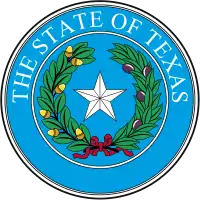Dallam County, Texas
Dallam County is the north-westernmost county in the U.S. state of Texas. As of the 2010 Census, its population was 6,703.[1] Its county seat is Dalhart.[2] The county was founded in 1876 and later organized in 1891.[3] It is named for James Wilmer Dallam, a lawyer and newspaper publisher.
Dallam County | |
|---|---|
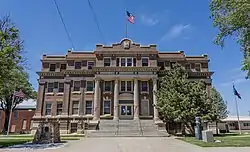 The 1922 Dallam County Courthouse in Dalhart | |
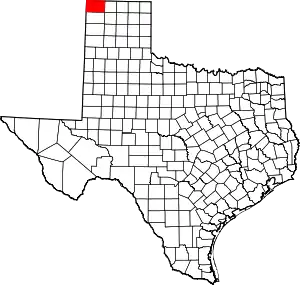 Location within the U.S. state of Texas | |
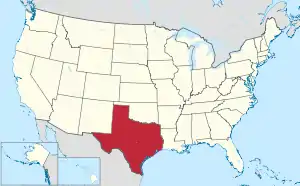 Texas's location within the U.S. | |
| Coordinates: 36°17′N 102°35′W | |
| Country | |
| State | |
| Founded | 1891 |
| Seat | Dalhart |
| Largest city | Dalhart |
| Area | |
| • Total | 1,505 sq mi (3,900 km2) |
| • Land | 1,503 sq mi (3,890 km2) |
| • Water | 2.0 sq mi (5 km2) 0.1%% |
| Population (2015) | |
| • Total | 7,121 |
| • Density | 4.5/sq mi (1.7/km2) |
| Time zone | UTC−6 (Central) |
| • Summer (DST) | UTC−5 (CDT) |
| Congressional district | 13th |
| Website | www |
Dallam is the northernmost of the 10 Texas counties that from 1885 to 1912 constituted the legendary XIT Ranch. The ranch is still celebrated through the XIT Museum in Dalhart and the annual XIT Rodeo and Reunion held the first long weekend in August.
History
Dallam County was formed in 1876 from portions of Bexar County. It was named after James Wilmer Dallam, the lawyer who made the first digest of Texas laws.[4] The first settlement in the area followed in 1870, which resulted in the Red River War of 1874 and 1875 with the native Comanche and Kiowa tribes. In 1900–01, the Chicago, Rock Island and Pacific Railroad company built a stretch from Liberal, Kansas, to Tucumcari, New Mexico, which ran through the county. The location where the tracks met those of the Fort Worth and Denver Railway was named Dalhart. The name is taken from the first letters of Dallam County and Hartley County, between which the town's area is divided. Within a short time, the small railroad stop turned into a sizable town and was named county seat in 1903.
Dallam County was one of the hardest-hit areas in the Dust Bowl.[5]
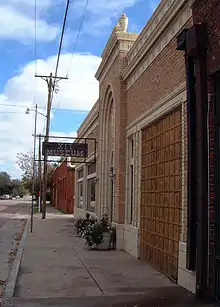
Geography
According to the U.S. Census Bureau, the county has a total area of 1,505 square miles (3,900 km2), of which 1,503 square miles (3,890 km2) are land and 2.0 square miles (5.2 km2) (0.1%) are covered by water.[6]
Dallam County is one of only three counties in Texas to border two other U.S. states (the others being Bowie and Cass). Dallam County forms part of the tripoint—of Texas-Oklahoma-New Mexico.
Major highways
 U.S. Highway 54
U.S. Highway 54 U.S. Highway 87
U.S. Highway 87 U.S. Highway 287
U.S. Highway 287 U.S. Highway 385
U.S. Highway 385 State Highway 102
State Highway 102
Adjacent counties
- Cimarron County, Oklahoma (north)
- Sherman County (east)
- Hartley County (south)
- Union County, New Mexico (west)
- Moore County (southeast)
National protected area
Demographics
| Historical population | |||
|---|---|---|---|
| Census | Pop. | %± | |
| 1890 | 112 | — | |
| 1900 | 146 | 30.4% | |
| 1910 | 4,001 | 2,640.4% | |
| 1920 | 4,528 | 13.2% | |
| 1930 | 7,830 | 72.9% | |
| 1940 | 6,494 | −17.1% | |
| 1950 | 7,640 | 17.6% | |
| 1960 | 6,302 | −17.5% | |
| 1970 | 6,012 | −4.6% | |
| 1980 | 6,531 | 8.6% | |
| 1990 | 5,461 | −16.4% | |
| 2000 | 6,222 | 13.9% | |
| 2010 | 6,703 | 7.7% | |
| 2019 (est.) | 7,287 | [7] | 8.7% |
| U.S. Decennial Census[8] 1850–2010[9] 2010–2014[1] | |||
As of the census[10] of 2000, there were 6,222 people, 2,317 households, and 1,628 families residing in the county. The population density was 4 people per square mile (2/km2). There were 2,697 housing units at an average density of 2 per square mile (1/km2). The racial makeup of the county was 82.64% White, 1.64% Black or African American, 0.90% Native American, 0.21% Asian, 12.41% from other races, and 2.20% from two or more races. 28.38% of the population were Hispanic or Latino of any race. In terms of ancestry, 19.6% were of German, 8,2% were of Irish, 7,1 % were of English, 5,5% were of American, 2,8% were of French, 2,7 % were of Scotch-Irish, 1,6% were of Dutch.
There were 2,317 households, out of which 39.00% had children under the age of 18 living with them, 55.10% were married couples living together, 9.70% had a female householder with no husband present, and 29.70% were non-families. 26.20% of all households were made up of individuals, and 10.00% had someone living alone who was 65 years of age or older. The average household size was 2.68 and the average family size was 3.24.
In the county, the population was spread out, with 31.80% under the age of 18, 8.60% from 18 to 24, 28.80% from 25 to 44, 20.60% from 45 to 64, and 10.30% who were 65 years of age or older. The median age was 31 years. For every 100 females there were 102.00 males. For every 100 females age 18 and over, there were 101.30 males.
The median income for a household in the county was $27,946, and the median income for a family was $33,558. Males had a median income of $27,244 versus $19,000 for females. The per capita income for the county was $13,653. About 11.30% of families and 14.10% of the population were below the poverty line, including 15.40% of those under age 18 and 24.80% of those age 65 or over.
Politics
Dallam County is located within District 86 of the Texas House of Representatives. The seat has been held by Amarillo attorney John T. Smithee, a Republican, since 1985. Dallam County as a whole is heavily Republican in orientation.
| Year | Republican | Democratic | Third parties |
|---|---|---|---|
| 2020 | 86.3% 1,389 | 12.2% 197 | 1.4% 23 |
| 2016 | 81.7% 1,261 | 14.4% 222 | 4.0% 61 |
| 2012 | 81.4% 1,248 | 16.5% 253 | 2.2% 33 |
| 2008 | 79.9% 1,269 | 19.0% 302 | 1.1% 18 |
| 2004 | 82.7% 1,473 | 17.1% 305 | 0.2% 4 |
| 2000 | 79.4% 1,385 | 19.6% 341 | 1.0% 18 |
| 1996 | 59.4% 970 | 29.6% 483 | 11.1% 181 |
| 1992 | 54.8% 922 | 25.8% 434 | 19.4% 327 |
| 1988 | 64.7% 1,205 | 34.6% 645 | 0.6% 12 |
| 1984 | 75.8% 1,594 | 23.6% 496 | 0.6% 13 |
| 1980 | 58.9% 965 | 38.6% 632 | 2.6% 42 |
| 1976 | 46.6% 936 | 51.3% 1,029 | 2.1% 42 |
| 1972 | 78.0% 1,271 | 20.1% 327 | 1.9% 31 |
| 1968 | 49.3% 990 | 29.3% 588 | 21.4% 430 |
| 1964 | 39.8% 700 | 60.2% 1,058 | 0.1% 1 |
| 1960 | 53.2% 961 | 46.2% 835 | 0.7% 12 |
| 1956 | 48.4% 1,018 | 51.1% 1,074 | 0.5% 11 |
| 1952 | 54.8% 1,464 | 44.8% 1,197 | 0.5% 12 |
| 1948 | 20.5% 399 | 77.4% 1,504 | 2.1% 40 |
| 1944 | 20.1% 323 | 69.4% 1,118 | 10.5% 169 |
| 1940 | 21.6% 427 | 78.0% 1,539 | 0.4% 8 |
| 1936 | 12.7% 220 | 83.2% 1,436 | 4.1% 71 |
| 1932 | 14.8% 341 | 84.1% 1,935 | 1.0% 24 |
| 1928 | 53.0% 618 | 46.2% 539 | 0.8% 9 |
| 1924 | 24.3% 254 | 48.4% 506 | 27.3% 285 |
| 1920 | 26.5% 195 | 65.0% 478 | 8.6% 63 |
| 1916 | 16.5% 81 | 74.1% 363 | 9.4% 46 |
| 1912 | 5.3% 18 | 72.4% 247 | 22.3% 76 |
Education
The following school districts serve Dallam County:
See also
References
- "State & County QuickFacts". United States Census Bureau. Archived from the original on August 6, 2011. Retrieved December 10, 2013.
- "Find a County". National Association of Counties. Archived from the original on May 31, 2011. Retrieved 2011-06-07.
- "Texas: Individual County Chronologies". Texas Atlas of Historical County Boundaries. The Newberry Library. 2008. Retrieved May 21, 2015.
- Gannett, Henry (1905). The Origin of Certain Place Names in the United States. Govt. Print. Off. pp. 99.
- Laskin, David (December 17, 2005). "Laying Bare Dust Bowl's Scar Tissue". The New York Times. Retrieved 17 January 2014.
- "2010 Census Gazetteer Files". United States Census Bureau. August 22, 2012. Retrieved April 22, 2015.
- "Population and Housing Unit Estimates". United States Census Bureau. May 24, 2020. Retrieved May 27, 2020.
- "U.S. Decennial Census". United States Census Bureau. Retrieved April 22, 2015.
- "Texas Almanac: Population History of Counties from 1850–2010" (PDF). Texas Almanac. Retrieved April 22, 2015.
- "U.S. Census website". United States Census Bureau. Retrieved 2011-05-14.
- Leip, David. "Dave Leip's Atlas of U.S. Presidential Elections". uselectionatlas.org. Retrieved 2018-07-21.
External links
| Wikimedia Commons has media related to Dallam County, Texas. |
- Dallam County commissioners’ website
- Dallam County in Handbook of Texas Online at the University of Texas
- Dallam County Profile from the Texas Association of Counties
- The XIT Ranch claims to have been the largest range in the world "under fence"
